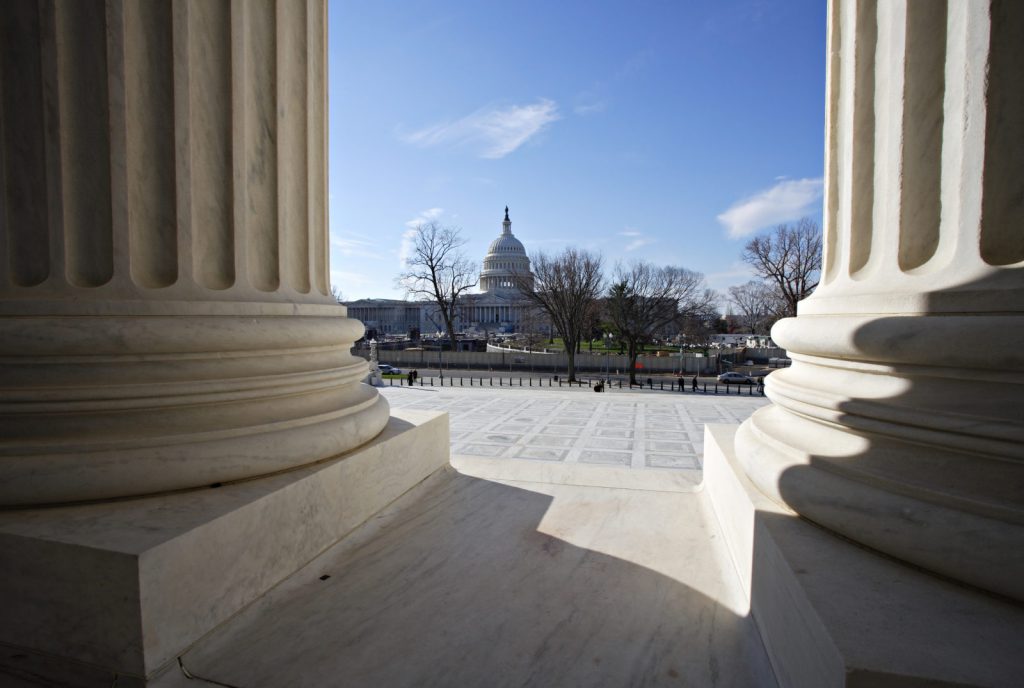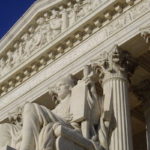
Published July 22, 2015
Click here to view video of the hearing. Mr. Whelan’s testimony begins at the 1:09:34 mark.
Testimony of Ed Whelan at Senate Hearing “With Prejudice: Supreme Court Activism and Possible Solutions”
EPPC President Ed Whelan submitted this written testimony in advance of his appearance as a witness at a Senate Judiciary subcommittee hearing on July 22, 2015.
Thank you very much, Chairman Cruz and ranking member Coons, for inviting me to testify before you and your subcommittee on this important topic.
I offer my views in my capacity as president of the Ethics and Public Policy Center and director of EPPC’s program on The Constitution, the Courts, and the Culture.[1] In that capacity, I have written and lectured widely on constitutional law and judicial nominations over the past decade, including on the Supreme Court nominations of John Roberts, Samuel Alito, Sonia Sotomayor, and Elena Kagan. I also draw on my additional experience in matters relating to the Supreme Court and constitutional law: During the Court’s October 1991 Term, I served as a law clerk to Justice Antonin Scalia. From 1992 to 1995, I worked for the Senate Judiciary Committee as a senior staffer to Senator Orrin Hatch (who was ranking member and then chairman during that period); I worked heavily on judicial nominations, including the Supreme Court nominations of Ruth Bader Ginsburg and Stephen Breyer. From 2001 to 2004, I served as principal deputy assistant attorney general in the Office of Legal Counsel in the U.S. Department of Justice.
Overview and Summary
The Supreme Court’s 5-4 ruling last month inventing a supposed federal constitutional right to marry a person of the same sex is brazenly lawless. In the flagrancy and magnitude of its errors in overriding, and cutting short, the democratic processes, Obergefell v. Hodges is rivaled in Supreme Court history only by Dred Scott v. Sandford (1857) and Roe v. Wade (1973).
The Court’s ruling in Obergefell shows, as Justice Alito observes in his dissent, that “decades of attempts to restrain [the] Court’s abuse of its authority have failed” and that there is a “deep and perhaps irremediable corruption of our legal culture’s conception of constitutional interpretation.” For the five justices in the Obergefell majority, “the only real limit” on what they or their ideological successors might do in other cases in the future “is their own sense of what those with political power and cultural influence are willing to tolerate.”
Some of the ordinary tools are available and necessary to respond to some of the damage that Obergefell threatens. In particular, there is an urgent need to protect churches and religious schools and charities from being severely penalized and driven out of operation merely because they adhere to the same understanding of marriage that President Obama professed to hold when he ran for president. It is essential that Congress enact specific religious-liberty protections along the lines of the First Amendment Defense Act that is now pending in both houses of Congress. It is likewise essential that the states enact similar legislation.
Another ordinary avenue that remains available for working to thwart the Court’s unconstitutional excesses is the election in 2016 of a president who will aim to appoint sound justices to the Court.
But the Court’s extraordinary abuses also call for consideration of extraordinary responses. Possible responses include a range of constitutional amendments—for example, to amend the amendment process itself, to override specific rulings, to provide a means besides impeachment for removing bad justices, or to impose term limits on Supreme Court justices. It’s worth emphasizing that voices on the Left have advocated some of these approaches.
None of these constitutional amendments, of course, would be easy to adopt, and careful consideration of their advantages and disadvantages is required. Further, if progress is going to be made, prevailing confusions about constitutional interpretation—especially those embedded in the “living Constitution” approach to judicial decision-making and in the myth of judicial supremacy—need to be dispelled. The challenge is great. But in the present state of affairs, the difficulty of the challenge is a poor excuse for inaction.
Judicial Review and Constitutional Supremacy
Our Constitution reflects two fundamental structural principles for dividing government power: separation of powers among the three branches of the federal government; and federalism, the division of authority between the federal government and the states. An important feature of both separation of powers and federalism is what has come over time to be known as the power of judicial review: the power of the federal courts to determine whether particular laws they are being asked to apply comport with the Constitution and, if they determine in the negative, to decline to give force to such laws.
In Federalist No. 78, Alexander Hamilton famously grounds the power of judicial review—the ability of the federal courts to operate “as the bulwarks of a limited Constitution against legislative encroachments”—in the supremacy of the Constitution as written law. As Hamilton explains, the Constitution
is, in fact, and must be regarded by the judges, as a fundamental law. It therefore belongs to them to ascertain its meaning, as well as the meaning of any particular act proceeding from the legislative body. If there should happen to be an irreconcilable variance between the two, that which has the superior obligation and validity ought, of course, to be preferred; or, in other words, the Constitution ought to be preferred to the statute, the intention of the people to the intention of their agents.
Further, Hamilton emphasizes repeatedly, the very legitimacy of judicial review is rooted in, and conditional on, the proposition that judges are really doing law:
It can be of no weight to say that the courts, on the pretense of a repugnancy, may substitute their own pleasure to the constitutional intentions of the legislature. This might as well happen in the case of two contradictory statutes; or it might as well happen in every adjudication upon any single statute. The courts must declare the sense of the law; and if they should be disposed to exercise WILL instead of JUDGMENT, the consequence would equally be the substitution of their pleasure to that of the legislative body. The observation, if it prove any thing, would prove that there ought to be no judges distinct from that body.
Thus, judicial review, properly understood, does not “by any means suppose a superiority of the judicial to the legislative power” but rather reflects the supremacy of the Constitution over ordinary statutes. Indeed, Hamilton observes, because the judiciary “may truly be said to have neither FORCE nor WILL, but merely judgment; and must ultimately depend upon the aid of the executive arm even for the efficacy of its judgments,” it “is beyond comparison the weakest of the three departments of power.”
The “Living Constitution” and the Myth of Judicial Supremacy
As we examine the modern landscape of Supreme Court decisions, it’s tempting to laugh or scoff at how wrong Hamilton was. But I would submit that the logic of his argument is rigorous and sound. What he surely didn’t foresee is how frequently and pervasively, especially in recent decades, a Supreme Court majority, “on the pretense of a repugnancy” between the Constitution and a law, would “exercise WILL instead of JUDGMENT” and “substitute [its] own pleasure to the constitutional intentions of the legislature.” Nor did he anticipate how cravenly the other federal branches and so many citizens would acquiesce in the judicial usurpations of the realm of representative government.
The rise and widespread (if largely unthinking) acceptance of two deeply unsound concepts of constitutional interpretation explains much about why we are where we are. The first is the so-called “living Constitution” approach to Supreme Court decision-making. Proponents of the “living Constitution” approach (whether using that euphemism or another one) typically contend that, for one reason or another, the judicial task of (in Hamilton’s phrase) “ascertain[ing] [the] meaning” of the Constitution is somehow no longer possible or desirable. The Constitution, they argue, in part declares majestic generalities that are of indeterminate meaning and in part sets forth rules and limits that are obsolete. But, as Hamilton recognized, insofar as the meaning of a clause of the Constitution is indeterminate, judges lack the authority to hold that a statute violates that meaning, for how can there be an “irreconcilable variance” between a statute and a constitutional provision of indeterminate meaning? As for supposed obsolescence: It’s no business of the courts to determine that the “bulwarks of a limited Constitution” should be ignored.
Proponents of the “living Constitution” also claim that freewheeling judicial authority to invent new constitutional rights is somehow needed to adapt our country to modern circumstances. But that claim ignores the broad play that the Constitution gives to the democratic processes to revise laws in light of changed conditions and perceptions. Even worse, by entrenching in the Constitution whatever rights five justices think important, living-constitutionalism deprives future generations of Americans of the very flexibility that it falsely claims to advance.
At bottom, the “living Constitution” approach is nothing more than an excuse for five justices to indulge and impose their own policy preferences—“to exercise WILL instead of JUDGMENT”—in the guise of discovering new constitutional rights. As one astute critic has put it, the “living” Constitution is really a “zombie” Constitution, with the corpse of the real Constitution reanimated with the Left’s favored positions.[2]
The second deeply unsound concept is the myth of judicial supremacy. According to this myth, the Constitution means whatever five Supreme Court justices claim it means, and all other governmental actors are duty-bound to abide by that supposed meaning. The myth of judicial supremacy pervades our legal culture, even as it is often invoked only selectively to protect and leverage favored rulings.
This mistaken concept of judicial supremacy is often confused with the power of judicial review that Hamilton expounded. But it is one thing for the Supreme Court to decline to apply a law that it deems to be unconstitutional; it is quite another for it to maintain that presidents, members of Congress, and state officials must likewise regard the law as unconstitutional and, further, must accept and follow the rationale of the Court’s decision.
Thus, Abraham Lincoln, in his first inaugural address, famously defended his rejection of the Dred Scott ruling: “If the policy of the Government upon vital questions affecting the whole people is to be irrevocably fixed by decisions of the Supreme Court, . . . the people will have ceased to be their own rulers, having to that extent practically resigned their Government into the hands of that eminent tribunal.” Lincoln’s actions as president were faithful to his words. In defiance of the dual holdings of Dred Scott, he signed into law a bill that outlawed slavery in the federal territories, and he instructed the State Department to issue passports to free blacks (thus recognizing them as citizens).
The Court did not propound the myth of judicial supremacy until 1958. But when it did so (in Cooper v. Aaron), it tried to concoct a venerable history. It falsely contended that Marbury v. Madison — the landmark 1803 ruling that expounded the power of judicial review — “declared the basic principle that the federal judiciary is supreme in the exposition of the law of the Constitution.” Even more brazenly, without any mention of Lincoln’s compelling refutation (or of Thomas Jefferson’s and Andrew Jackson’s similar contestations), the Court asserted that the concept of judicial supremacy had “ever since [Marbury] been respected by this Court and the Country as a permanent and indispensable feature of our constitutional system.”
These two mistaken concepts operate in tandem to reinforce each other. Living-constitutionalists render unsound—indeed, unconstitutional—rulings and then invoke the myth of judicial supremacy to demand acquiescence to those rulings.
The Judicial Assault on Marriage
The judicial assault on marriage that culminated in the Supreme Court’s 5-4 decision last month inventing a supposed federal constitutional right to marry a person of the same sex provides a stark illustration of how utterly and recklessly lawless the Supreme Court can be.
For starters, it is important to observe how radically unstable living-constitutionalism is.
In 1972, two gay activists filed an appeal in the Supreme Court claiming that a state law defining marriage as a male-female union violated the federal Constitution. In dismissing the appeal “for want of a substantial federal question,” a unanimous Supreme Court (in Baker v. Nelson) treated the claim as so frivolous, so clearly devoid of merit, that there was no point in bothering with briefing and oral argument. Among the justices who joined in that dismissal were three of the most aggressive left-wing living-constitutionalists ever — William O. Douglas, William Brennan, and Thurgood Marshall.
That dismissal was no surprise, of course, as the laws of every state had defined marriage as the union of a man and a woman when the Constitution was first adopted and when the 14th Amendment was ratified (as well as every moment between and since).
In 1996, Congress enacted, and President Clinton signed into law, the federal Defense of Marriage Act. DOMA had two substantive provisions. One provision defined marriage, for purposes of provisions of federal law only, as the union of a man and a woman. The other provision declared that no state shall be required to give effect to any public act of another state that treats a relationship between persons of the same sex as a marriage. Both provisions, in short, reflected the judgment of Congress and the president that it is constitutionally permissible to define marriage as the union of a man and a woman. Indeed, DOMA passed overwhelmingly in both Houses of Congress—by a vote of 85–14 in the Senate and a vote of 342–67 in the House. There has of course been a great deal of turnover in Congress over the intervening two decades. But among the House members who voted for DOMA were two individuals who now sit on this subcommittee: Senator Dick Durbin and Senator Charles Schumer. Other current Democratic senators who voted for DOMA, either as senators or as House members, include Senators Benjamin Cardin, Patrick Leahy, Bob Menendez, Barbara Mikulski, Patty Murray, Jack Reed, and Harry Reid. Ditto for then-Senator Joseph Biden.
Barely a decade ago, a living-constitutionalist law professor who supports same-sex marriage — Cass Sunstein, later the regulatory affairs czar in the Obama White House — testified to the Senate Judiciary Committee that it was inconceivable that the Supreme Court, “as currently constituted,” would decide there is a constitutional right to same-sex marriage.[3] To posit the threat of such a ruling, Sunstein asserted, involved a “reckless conception of what is on the horizon and it is indefensible by reference to anything any Supreme Court Justice has said, at least on the bench, and I believe even off the bench.”
When Barack Obama ran for president in 2008, he tried to hide his previous support for redefining marriage to include same-sex couples, and he professed his deep belief that marriage is the union of a man and a woman. He thus also clearly espoused the view that it is constitutionally permissible to define marriage as a male-female union. Indeed, even as his public position on marriage policy crumbled—or, rather, “evolved”—President Obama continued to maintain that states had authority to define marriage as a male-female union. It wasn’t until last October that President Obama publicly embraced the view that there is a constitutional right to marry a person of the same sex.[4]
How is it that just last month five living-constitutionalist justices would find compelling and meritorious the same claim that their more extreme ideological predecessors regarded as frivolous four decades ago? There’s no doubt that the public’s position on issues related to homosexuality, like that of many politicians, changed considerably over that period, and those changes would reasonably be expected to be reflected in revised laws and policies. But the 14th Amendment did not change one iota.
What happened, I would submit, is simple: Same-sex marriage rose high on the Left’s agenda. Five justices decided that it was a good idea. And they figured they now had ample political cover to impose it on the American people as a supposed constitutional right.
But the constitutional question in Obergefell was not whether it’s a good idea to redefine marriage to include same-sex couples. It was instead whether the Court would foreclose the ability of the people in each state to decide that important question for themselves. In denying American citizens their rightful authority over that question, the Court majority acted unconstitutionally and displayed (in the Chief Justice’s words) an “extravagant conception of judicial supremacy.”
In his majority opinion, Justice Kennedy conceded that all of the Court’s precedents recognizing a right to marry “presumed a relationship involving opposite-sex partners.” But, to Kennedy, that presumption reflected the blinkered understanding of past ages. It was left to the dissenters to point out the elementary fact that the sexual complementarity embedded in the historical definition of marriage, far from being an incidental feature, is rooted in the unique procreative capacity of heterosexual intercourse. That reality doesn’t mean that the people can’t redefine marriage through democratic processes. But it does explain why the constitutional right to marry that the Court has recognized doesn’t extend to same-sex couples.
The Court’s ruling poses severe threats to marriage. The collapse of our marriage culture in recent decades — a collapse for which heterosexuals are responsible — has produced a society in which more than 40 percent of births now occur to unmarried mothers. That collapse has resulted from the weakening of the bond between marriage and procreation — from the widespread rejection of the principle that (as the Chief Justice put it in his dissent) “for the good of children and society, sexual relations that can lead to procreation should occur only between a man and a woman committed to a lasting bond.”
The redefinition of marriage — in the guise of the Constitution, no less — to include same-sex couples formally eliminates any connection between marriage and procreation. Heterosexual marriage will suffer — not because heterosexuals see the guys next door getting married but because the law is now proclaiming that marriage has nothing to do with procreation. Further, candid gay activists acknowledge that non-monogamy is rampant in gay marriages, and they celebrate that the redefinition of marriage will undermine the norm of marital fidelity.[5]
Speaking of non-monogamy: The Chief Justice observed in his dissent that although Justice Kennedy’s opinion “randomly inserts the adjective ‘two’ in various places, it offers no reason at all why the two-person element of the core definition of marriage may be preserved while the man-woman element may not.” In the immediate wake of the marriage ruling, more and more advocates of polyamory have come out of the closet to argue that the arguments for same-sex marriage support a right to plural marriage. Indeed, the best argument that we are not sliding fast down the slippery slope is that the polygamist version (one husband, many wives) of polyamory has been historically common and is thus arguably upslope from same-sex marriage.
By misbranding defenders of marriage as opponents of the Constitution, the Court’s ruling will also sharply intensify the threats to religious liberty. Perhaps the most revealing moment at oral argument in Obergefell came when the Solicitor General candidly admitted that the nonprofit tax status of institutions that oppose same-sex marriage was “certainly going to be an issue.” Religious schools that live out their beliefs also will be threatened with discrimination lawsuits and the risk of losing their accreditation. Religious charities face being ineligible for government grants and contracts. And individual Americans who hold the same beliefs about marriage that President Obama professed when he was elected can expect to be penalized, marginalized, and stigmatized.
The Court’s ruling also presents a difficult challenge to state officials who understand that they have sworn to uphold the Constitution — not the Supreme Court’s mistaken interpretations of it — and who recognize that their state laws defining marriage as the union of a man and a woman are valid and enforceable under the real Constitution. It is appalling that the Court has put them to a choice between acquiescence to its own flagrant illegality and obedience to the Constitution.
The Broader Problem
In the larger picture, Obergefell is, like Roe v. Wade, a particularly egregious example of the broader problem of living-constitutionalist decisions over the past five decades.
What Obergefell shows is that there is no rewriting of the Constitution that is beyond the bounds of the possible if something matters to the Left and there are five or more living-constitutionalist justices on the Court. Indeed, Justice Ruth Bader Ginsburg and Justice Stephen Breyer illustrated the point in another case at the end of the Term in which, after more than 20 years each on the Court, they suddenly called into question the constitutionality of the death penalty.
The list of possible living-constitutionalist innovations is endless: Voting rights for illegal aliens; taxpayer funding of abortion and of sex-change operations; mandatory equalized spending for public-school districts; a right to welfare payments above the poverty line; and a right to have multiple spouses.
Other innovations might also severely impair existing rights. Legal academics are enamored of restrictions on so-called “hate speech”— an amorphous category that is already expanding to include criticism of racial preferences or use of male pronouns to refer to a man who thinks he’s a woman. The First Amendment, as long construed, would bar the government from imposing such restrictions. But that’s no barrier against five willful justices. Ditto for a robust understanding of religious liberty and for Second Amendment rights to firearms.
Possible Solutions
There is no easy solution to the Supreme Court’s abuse of the Constitution. Any meaningful solution will take time and will require dispelling pervasive confusions about the Court’s proper role—especially those confusions embedded in the “living Constitution” approach and in the myth of judicial supremacy. It’s also important to think carefully about the possible unintended consequences of any particular reform proposal.
But this is no time to make the perfect the enemy of the good. Proposed solutions need to be compared to each other and to the status quo, not to some imagined ideal.
At least four types of constitutional amendments deserve attention. The first type, of which there could surely be several versions, would modify Article V of the Constitution to make it easier to amend the Constitution (and thus to formally reject lawless Supreme Court decisions). Article V now provides two means for proposing amendments: (1) a two-thirds vote in both houses of Congress; or (2) a convention called by Congress upon request by the legislatures of two-thirds of the states. Article V also gives Congress a choice between two means for ratifying proposed amendments: (1) legislatures of three-fourths of the states; or (2) conventions in three-fourths of the states. An amendment to Article V could modify the proposal mechanisms, the ratification mechanisms, or both.
Yale law professor Bruce Ackerman has proposed one such amendment.[6] (Ackerman, I’ll note, is no conservative, and his amendment is motivated by what he sees as the threat of a “stealth constitutional revolution” by conservative justices.) Under Ackerman’s so-called “Popular Sovereignty Initiative,” a president who has been elected to a second term would have the authority to propose constitutional amendments. Upon approval by both houses of Congress, the amendments would be placed on the ballot at the time of the next two presidential elections. A 60% approval of the nation’s voters at both elections would be needed in order for the amendments to become part of the Constitution.
Simpler variants are also available. For example, the two-thirds threshold for states to request a convention for proposing amendments could be substantially lowered. In addition or alternatively, the three-fourths threshold of state legislatures needed to ratify amendments could be lowered (or the aggregate effective veto power of less populous states could otherwise be reduced).
A second type of constitutional amendment would enable Congress or the aggregate of state legislatures to directly invalidate a Supreme Court ruling. Again, many variants are possible, but the basic concept is that there would be a mechanism by which a Supreme Court ruling could be immediately teed up for review. Rejection might hinge on the vote of a specified supermajority in each house of Congress or of a supermajority of state legislatures.
A third type of constitutional amendment would provide a means, in addition to impeachment and conviction, for removing bad justices. Chairman Cruz’s proposed amendment to establish a system of retention elections for justices is of that type. Under Chairman Cruz’s amendment, each justice would face a retention election in the second national election after his or her appointment and every eight years thereafter. A negative vote of both the majority of voters overall and the majorities in at least half the states would be needed to remove the justice from office. (Again, there are obviously plenty of other variants of this approach.)
A fourth type would impose term limits on the justices. This sort of proposal has won support from people on both sides of the political spectrum, from conservative law professor Steven G. Calabresi[7] to liberal commentator Linda Greenhouse.[8] Under the most common version of this proposal, each justice would serve an 18-year term, and each of the nine slots would become vacant every two years. This proposal does not directly address the problem of bad justices—it would impose term limits on all justices—and its proponents often have other reasons for supporting it. (Calabresi, for example, regards life tenure—especially now that lifespans have extended so long—as “essentially a relic of pre-democratic times,” whereas Greenhouse hopes that regular vacancies, twice for each presidential term, “might lower the temperature surrounding each vacancy.”) But some proponents, concerned about the “corrupting influence of life tenure,” think that term limits might well have the beneficial effect of making justices more faithful to the Constitution.[9]
Other types of constitutional amendments to rein in the Court’s excesses have also been proposed. For example, Harvard law professor Mark Tushnet, coming from the Left, has advocated an amendment that would abolish the power of judicial review altogether.[10]
Other approaches are also worthy of examination. Some argue, for example, that term limits for Supreme Court justices could effectively be achieved via statute.[11] Statutes to strip the jurisdiction of the federal courts over certain classes of cases are another option. A more muscular resort to the existing impeachment option might have beneficial consequences. Further, by some counts, the number of states calling for Congress to call a convention for proposing amendments is just shy of the two-thirds needed.
I emphasize that I am not here endorsing any of these reform proposals. But they are illustrative of the sorts of reforms that urgently deserve careful and considered attention.
Thank you.
[1] I am offering only my own views; I am not presenting the views of the Ethics and Public Policy Center as an institution.
[2] See Steven Menashi, “The Undead Constitution,” Policy Review, Oct./Nov. 2009.
[3] Transcript, Hearing before the United States Senate, “A Proposed Constitutional Amendment to Preserve Traditional Marriage,” S. Hrg. 108-763, 108th Cong. 2nd sess., March 23, 2004, available at http://www.gpo.gov/fdsys/pkg/CHRG-108shrg98156/html/CHRG-108shrg98156.htm.
[4] See Jeffrey Toobin, “The Obama Brief,” New Yorker, Oct. 27, 2014.
[5] See, e.g., Scott James, “Many Successful Gay Marriages Share an Open Secret,” New York Times, Jan. 28, 2010.
[6] See Bruce Ackerman, “We the People Rise Again,” Slate, June 4, 2012.
[7] See Steven G. Calabresi & James Lindgren, Term Limits for the Supreme Court: Life Tenure Reconsidered, 29 Harv. J. L. & Pub. Pol. 769 (2006).
[8] Linda Greenhouse, “The 18-Year Bench,” Slate, June 7, 2012.
[9] Saikrishna B. Prakash, “America’s Aristocracy,” 109 Yale L.J. 541, 578-580 (1999).
[10] Mark Tushnet, Taking the Constitution Away from the Courts 175 (1999).
[11] See Calabresi & Lindgren, supra, at 855-871 (discussing statutory proposals and presenting constitutional objections to them).
Ed Whelan is president of the Ethics and Public Policy Center.













